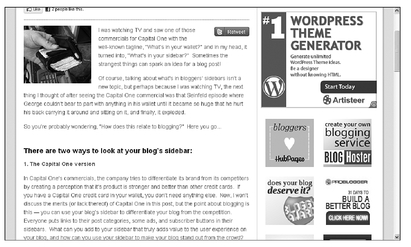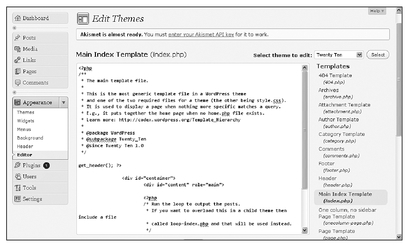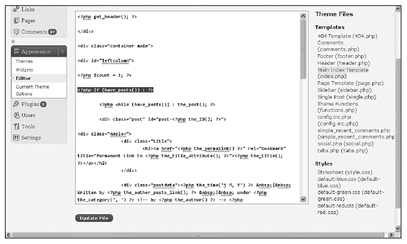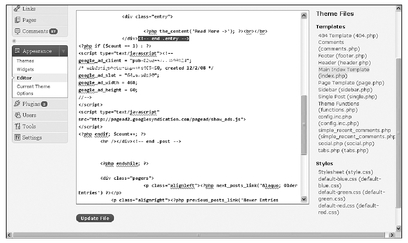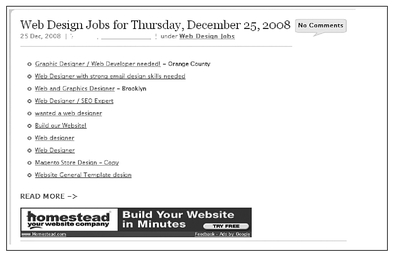Chapter 23
Making Money with Your Blog
In This Chapter
• Making money from your blog
• Choosing a blog monetization method
• Warnings to heed
• Where to display ads on your blog
Many people publish blogs with the hope that one day they’ll be able to make a passive income from their efforts by publishing ads, product reviews, and similar content on their blogs in exchange for payment. If you’d like to make money from your blog one day, this chapter is for you.
In this chapter, you learn about the most popular blog monetization methods and how the various opportunities differ in terms of effort and payment. You also learn about the negative aspects of blog monetization you should be aware of before you get started. Blogging can lead to earning money, but there are precautions you should take to ensure your blog benefits from monetization rather than being hurt by those efforts.
Popular Monetization Methods
There are a number of different ways to make money from your blog. Some are easier to implement than others, and some are more noticeable than others. The trick is testing different monetization methods to find the ones that generate revenue without damaging your blog’s reputation or the user’s experience.
Following are some of the most common forms of blog monetization.
Advertising: Image ads, text link ads, video ads, and flash-animated ads are just a few options.
PROCEED WITH CAUTION
If you use
WordPress.com as your blogging application and host, know that the WordPress terms of use state that you cannot place ads of any kind on your blog. Be sure to read the most recent terms of use to ensure you’re not breaking them with blog monetization efforts.
Reviews and paid posts: You can write reviews about products, services, websites, and more on your blog in exchange for a product sample or money.
Selling merchandise: Websites like
Cafepress.com,
Prinfection.com, and
Zazzle.com make it easy for you to create your own online storefront and link it to your blog so you can sell merchandise from that company (or your own designs).
Accepting donations: Accept monetary donations on your blog by placing a donation button or message in your blog’s sidebar.
INSIDER SECRET
PayPal offers donation buttons you can link to your PayPal account, so visitors can donate via PayPal with the click of a button. Simply follow the directions at
www.paypal.com/us/cgi-bin/webscr?cmd=p/xcl/rec/donate-intro-outside, and paste the provided code into a text widget in your blog’s sidebar to add a donation button to your blog.
These are by no means the only ways to make money from your blog, but they’re the most commonly used methods beginner bloggers can experiment with.
Analyzing Monetization Methods
Before you dive into the world of blog monetization, there are some things you need to understand so you can effectively analyze opportunities and pick the monetization methods most likely to help you meet your blogging goals.
As mentioned earlier, a lot of blog advertising and monetization opportunities can be found online, and not all programs are created equal. Venture into the world of blog monetization bearing in mind the following criteria:
Payment models: How you get paid matters. For example, you could be paid a flat rate for publishing an ad for a specific amount of time, or you might only be paid if a visitor to your blog clicks on an ad and then makes a purchase.
Payout thresholds: Some advertisers set payout thresholds that define a specific dollar amount you must earn through their ads displayed on your site before you’re paid for those ads. If a payout threshold is set, be sure it’s one you can reach within a period of time acceptable to you.
Relevance to your blog: If ads are irrelevant to the blog topic, they’re unlikely to be of interest to your visitors and may not help you earn money at all.
INSIDER SECRET
It’s unlikely you’ll make much money from any form of blog monetization until your blog traffic increases to approximately 10,000 or more page views per month … but you never know!
Audience: Use the information you have about your visitors to gain a better understanding of who your audience is and what they want and need from you and the ads on your blog.
Reputation: Do some research and be sure the reputation of the company or advertising program or network you’re considering working with is in good standing.
Customer service and help: Choose an advertising program that offers readily available customer service support.
Reports: Be sure the ad programs you use provide reports so you can track the performance of published ads and your earnings to ensure you couldn’t make better use of that space with a different ad.
Competition: Some online advertisers set rules telling you that you can’t display similar ads, competitor ads, or other specific types of ads while their ads are running on your blog. This can be very limiting for your earnings potential.
Warning! Warning!
Making money from your blog might sound like a great idea, but there are things you should not do if you want to ensure your blog retains its audience, continues to attract new visitors, and stays in the good graces of search engines such as Google. Furthermore, you need to be aware of online advertising laws that affect bloggers—and follow them!
Here are some things you should avoid when it comes to blog monetization:
Getting too intrusive: Your blog monetization efforts shouldn’t interrupt the user experience on your blog.
Detracting from the user experience: Ads and monetization tactics should enhance the user experience on your blog and add value to it, not damage it.
Being mistaken for spam: Search engines like Google identify websites that publish more ads than original content as spam. Even if only one page of your blog contains more ads than original content, visitors, Google, or other search engines could flag your entire blog as spam. If that happens, your blog might be removed from search engine results entirely, and the traffic that comes to your blogs from search engines will plummet.
Breaking the law: Even bloggers must follow the law, and the onus is on the publisher, or the blogger, to know what laws apply to them. Pleading ignorance won’t work in a court of law, so be certain you understand the legalities related to any monetization program or tactic you use on your blog.
PROCEED WITH CAUTION
If you publish paid reviews or endorsements, you need to follow the Federal Trade Commission guidelines in the Code of Federal Regulations (CFR), Title 16, Part 255, which can be found in the Electronic CFR at
ecfr.gpoaccess.gov.
Some WordPress themes make it extremely easy to insert ads into multiple areas of your blog by offering configuration settings where you can simply paste the requested information from your advertising program. Others are not as easy and require that you edit your blog theme’s CSS files to do so.
Fortunately, there are some simple ways to add advertisements to various areas of your blogs.
Inserting Ads in Your Blog’s Sidebar
Inserting ad code into a text widget in your blog’s sidebar, like those shown in Figure 23-1, is a very easy way to publish ads on your blog.
Figure 23-1 Insert ads into text widgets in your blog’s sidebar.
Simply click the Widgets link in the Appearance section of your WordPress dashboard’s left menu to open the Widgets page, where you can click and drag a text widget to your blog’s sidebar. Simply paste the ad code from the advertiser into the text widget, and the ads should begin displaying.
Inserting Ads Between Blog Posts
Some bloggers like to put ads in between blog posts. This isn’t hard to do if you’re comfortable pasting code into your theme’s CSS files. One of the easiest ways to do it is simply inserting an ad immediately after a blog post.
QUICK TIP
I’ve said it before, and I’ll say it again: always copy and paste the original code in your theme file before you edit it. If you make a mistake, it’s easy to go back to the original code.
Log in to your WordPress dashboard, and click the Editor link in the Appearance section of your dashboard left menu to open the Edit Themes page. Click the index. php file under the list of Templates on the right side of your screen to open the index. php file, as shown in Figure 23-2.
Figure 23-2 Insert code into the index.php file to display ads between posts.
Locate the code in the file that says <php if (have _posts ()) : ?>, and place your cursor immediately before that code, as shown in Figure 23-3. Type the following code where your cursor is placed: <?php $count = 1 ; ?>
Figure 23-3 Insert code into the index.php file to identify which post you want your ad to display after.
QUICK TIP
To place the ad under a specific post on your blog, you can change the number in the code you insert from “1”—meaning the ad will appear beneath the first post on your blog—to another number.
Once that code is added, you can paste the code for the ad you want to display into the
index.php file. Locate the code that says <!-- end .entry --> in your
index.php file, as shown in Figure 23-4.
Figure 23-4 Insert your ad code into your theme’s index.php file.
Place your cursor immediately after that code, and paste the ad code in that position. Click the Update File button to save your changes. Ads will start to display below your first blog post similar to the example shown in Figure 23-5.
Some WordPress theme CSS files are structured differently from the example shown in this chapter. If the code you need isn’t in your theme’s
index.php file, it may be in a separate
loop.php file. If your theme is not as clear as the one used in this example, contact the theme developer for help or try to use one of the plug-ins listed later in this chapter to position ads on your blog.
Figure 23-5 You can insert ads after a post in your blog.
Insert Ads in Your Blog’s Header or Footer
The process of inserting ads into your blog’s header depends on the theme you’re using and how your header is laid out. Inserting ads in your blog’s footer is easier, particularly if your footer is widgetized. Alternately, you can use the WP Footer Ad plug-in (
wordpress.org/extend/plugins/wp-footer-ad) to insert ads into your blog’s footer.
INSIDER SECRET
The WordPress support forum at
wordpress.org/support is a great place to search for specific steps to insert ads on your blog or to post your own question and get help from other users.
Inserting Ads in Blog Posts
You can insert ads into your blog posts by editing your
post.php file in your WordPress CSS editor so ads always appear in the same location in all your blog posts. The spot where you insert your ad code varies depending on where you want ads to appear. For example, you can insert ads at the beginning of your posts, right aligned, left aligned, at the end of your posts, and so on. It’s up to you. Just remember that you don’t want ads to detract from the content in your posts and interrupt or damage the user experience on your blog.
Fortunately, a number of WordPress plug-ins can help you manage ads and place ads in a variety of locations on your blog. Here are a few plug-ins you can test to see if they offer the help you need for the ad program you participate in:
Remember, the WordPress Codex is an excellent resource to get answers to questions about editing theme files. Additionally, you can find resources to learn CSS in Chapter 17, which will make it even easier for you to insert ads anywhere you want on your WordPress blog.
The Least You Need to Know
•
WordPress.com users cannot place paid ads on their blogs per the WordPress. com terms of service.
• You can monetize your blog through ads, reviews, selling merchandise, donations, and more.
• Ads should enhance the user experience on your blog, not damage it.
• Inserting ad code typically involves using widgets or plug-ins or editing your blog’s theme CSS files.




